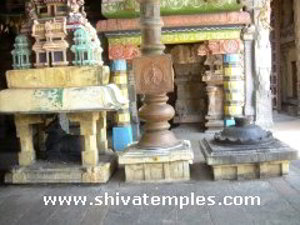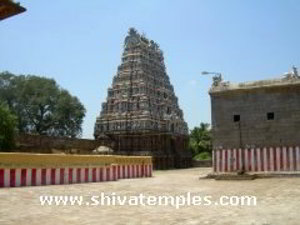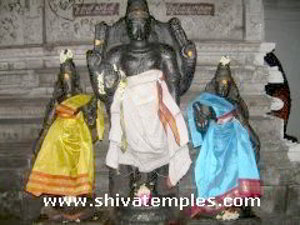Pazhamalainathar Temple, Tirumudukundram
Location: Tirumudukundram (Vriddhachalam)
Deity known as: Pazhamalainathar, Vriddhachalehswarar
Female Deity: Periya Nayaki, Vriddhaambikai
Pathikam: Tirunavukkarasar - 1, Sambandar - 7, Sundarar - 3
Gallery - Pazhamalainathar Temple
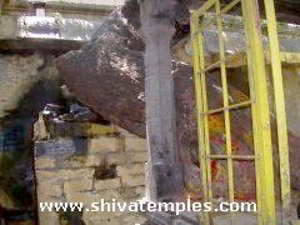
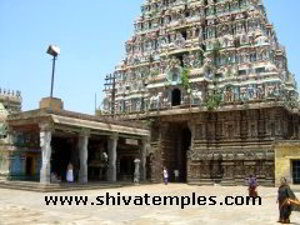
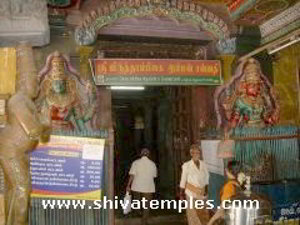
How to Reach
This Shiva temple is located in Vridhachalam, about 215 km from Chennai. The town is well connected by bus from most parts of Tamil Nadu and lies on the railway line between Chennai and Tiruchirapalli. The nearby towns are Panruti and Ulundurpettai.
Temple Address
Virudhachalam
Virudhachalam Post
Cuddalore District
PIN 606001
Temple hours
Morning: 6:00 AM - 12:00 PM
Evening: 4:00 PM - 8:00 PM
Temple Layout and Architecture
Temple Layout
The Shiva temple at Virudhachalam, also known as Tirumudukundram, stands as a remarkable example of temple architecture. Enclosed by imposing walls that rise to a height of about 26 feet, the temple complex extends 660 feet in length and 390 feet in breadth, presenting an awe-inspiring sight. Each of the four sides of the temple features a magnificent seven-tiered gopuram, enhancing the grandeur of the structure. The eastern gateway serves as the main entrance, leading devotees into a 16-pillared mandapam.
Pathaala Vinayakar - Second Padai Veedu
Within the outermost prakaram, there is an east-facing sanndhi for Vinayaka, located about 18 feet below ground level. This unique deity, known as Pathaala Vinayaka, is revered for his divine power to remove obstacles and shortcomings in one’s life, attracting devotees seeking blessings for prosperity and well-being. The six sacred temples associated with Muruga, known as the Arupadai Veedu, are well known for their spiritual importance. Similarly, Vinayaka is also believed to have six such Padai Veedus. Among them, the Pathaala Vinayaka at Virudhachalam is regarded as the second Padai Veedu of Vinayaka.
Deities and Sanndhis
The Goddess of this temple, Periya Nayaki Ammai, has a separate east-facing sannidhi situated on the northern side of the first prakaram. In the third prakaram, one can find the idols of the 63 Nayanmars and a sannidhi for Bindu Madhava Perumal. Notably, the Kalabhairava Murtham in this temple bears a striking resemblance to the one at Kasi, adding to its sacred significance.
Origin of the Name
Before beginning the act of creation, Brahma is said to have prayed to Shiva. In response, Shiva manifested Himself in the form of a hill, enabling Brahma to replicate it and thus create the other hills and mountains. Since this sacred hill existed prior to all others formed by Brahma, it came to be known as “Pazhamalai” — where “pazhamai” means ancient and “malai” means hill. The presiding deity here is therefore worshipped as Sri Pazhamalainathar.
The sanctum of the presiding deity, Pazhamalai Nathar, is located in the fourth prakaram, with Dwarapalakas guarding its entrance. The sannidhi of Goddess Vruthambikai is situated in the north-west corner of the third prakaram.
The Agama Temple
The Shaiva Agamas, sacred scriptures of Shaivism, are regarded with great reverence, holding a place of honor alongside the Vedas. Within this temple, there are 28 Shiva Lingams, each representing one of the 28 ShivAgamas, and they are believed to have been installed and worshipped by Lord Muruga himself. These Lingams are enshrined in a separate sannidhi situated in the north-western part of the Kailasa Prakaram, neatly arranged in two rows — one along the south and the other along the west. Ganesha is positioned at the center of the southern row of Lingams, while Muruga with his consorts occupies the central place among the western row of Lingams.
The 28 Agama Lingams
Each of these lingams is named after a specific Agama: Kamikeshwar, Yogeshwar, Chindiyeshwar, Kaaraneshwar, Ajitheshwar, Deepadeshwar, Sookshameshwar, Sahasreshwar, Amshumaaneshwar, Saprabhadeshwar, Vishayeshwar, Vishwasheshwar, Swayambeshwar, Analeshwar, Veereshwar, Rowraveshwar, Makuteshwar, Vimaleshwar, Chandragyaneshwar, Mukambibeshwar, Purothgeetheshwar, Lalitheshwar, Sidheshwar, Santhaneshwar, Sarvothameshwar, Paremshwar, Kiraneshwar, and Vathuleshwar. This distinctive layout of the lingams has earned the temple the title of 'Agama Temple', highlighting its special connection to the sacred texts and rituals of Shaivism.
Temple Significance and Legends
The Sacred Vanni Tree
The sthala vruksham of this temple is the ancient Vanni tree (Rusty Acacia), believed to be around 3,000 years old. According to legend, Sage Vipasittu offered the leaves of this Vanni tree as wages to the laborers engaged in the temple’s renovation. Miraculously, the leaves transformed into gold coins, the number of coins exactly matching the amount of work performed by each laborer.
Tirupugazh Sthalam
The 14th-century saint-poet Arunagirinathar composed three hymns in praise of Lord Muruga at this temple. The deity is depicted seated on a peacock, accompanied by his two divine consorts, Valli and Deivanai.
Sundarar's Gold Coins
When Sundarar sang the pathikam in praise of Pazhamalainathar, he was rewarded with 12,000 gold coins. As he was on his way to Tiruvarur, Sundarar worried about carrying the treasure. At his request, Pazhamalainathar miraculously cast the coins into the nearby Manimutharu river, blessing Sundarar that the coins would later be available to him at the Kamalalaya Theertham in Tiruvarur.
Vruthakasi – Superior to Kasi
According to the Skanda Purana, the souls of those who depart here are comforted by Periya Nayaki, while Pazhamalainathar himself imparts the Panchakshara Mantra. For this reason, the temple is also known as Vruthakasi — a place considered even better than Kasi. Worshipping here is believed to bestow punniya (spiritual merit) equivalent to that gained by visiting Kasi.
Vruthachalam is renowned as a Mukthi Sthalam, similar to Kasi. Bathing in the Manimutharu, located near the north gopuram, and offering prayers to Pazhamalainathar is considered as purifying as bathing in the Ganges and worshipping Kasi Vishwanathar. Legends hold that the remains of deceased individuals immersed in this river are eventually transformed into pebbles.
Festivals
Major festivals celebrated here include Aadi Pooram, Vaikasi Vasantha Urchavam, Margazhi Tiruvadirai, Masi Makam, and the annual Brahmotsavam, all observed with great grandeur.
The Legend of Gurunamasivaya and Balambika
The 16th-century saint Gurunamasivaya once stayed overnight at Thirumudukundram while traveling from Thiruvannamalai to Chidambaram. After offering prayers to Pazhamalai Nathar and Periya Nayaki, he rested within the temple. Known for always praying to Goddess Parvathy whenever he was hungry, the saint here sang hymns in praise of Periya Nayaki, affectionately referring to her as an “old lady” (Kizhathi) in his verses.
Pleased by his devotion, Periya Nayaki appeared before him in the form of an old lady and asked, "Why have you addressed me as an old lady? How could an old lady provide food and water for you?"
Realizing his mistake, the saint referred to the goddess as a beautiful young woman. Pleased, Periya Nayaki appeared in youthful form and fed Gurunamasivaya. Today, she is worshipped as Balambika in a dedicated sannidhi within the temple, commemorating this divine interaction.
More Gallery
